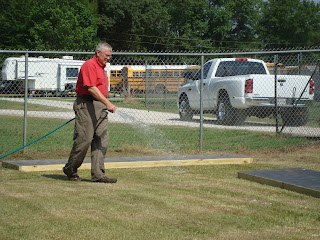Hydrangeas are fussy
plants this time of year due to extreme heat.
Do I water or do I not water? The hydrangeas are wilted when I get home,
but in the morning they look normal.
Hydrangeas need water, but not too much water. They require well drained soil and about six
hours of sunlight. If you give them too
much water it will encourage disease.
They are prone to root rot and fusarium wilt when they get and keep wet
feet, so before you plant your hydrangeas, amend the soil to help with
drainage. Root rot is exactly what it sounds like, the root system get soaked
for extended periods of time and rots away.
Fusarium wilt is a soil born pathogen and develops a fungus which clogs
up the vascular system of the plant and keeps it being able to take up
water. The leaves will start to yellow
and wilt from both of these conditions and make you think they need water when
they don’t. There is no real cure when
they get to this point, except to shovel prune them. Hydrangeas are also susceptible to leaf spot,
blights, and powdery mildew. These
problems are best controlled also by water management along with well drained
soil. A good fungicide can also help
with these. I would recommend daconil
combined with mancozeb. After speaking with a plant pathologist friend today, he recommends that a systemic fungicide containing the active ingredient propiconazole. I have observed
these problems in my own landscape. I
have lost a couple of my hydrangeas, but managed to correct the problem and
salvage the rest of them. This problem
also affected the homestead verbena and we lost a good sized area of that too. I have always been content not to prune
hydrangeas except to get flowers for drying.
A good friend who is a gardener’s gardener, laughingly told me that is
why the ones up next to the door bloom so profusely. He says to prune them when the blooms start
to fade and this will promote new growth which will give more blooms. He did agree that you should not prune the
ones that bloom on old wood after the end of July as they start setting their new
flowering buds at this time.
Despite all
this about disease, hydrangeas are relatively easy to grow. Prepare the planting site by adding at least half
again organic matter and you should have years of enjoyment from your hydrangea
plant. Fertilize them in March, May, and July with a good general purpose
fertilizer such as 8-8-8, 10-10-10, or13-13-13.
Be careful not to add nitrogen rich fertilizer as this could keep them
from producing blooms. Water in the
morning and preferably use a drip system as opposed to watering overhead.
If you have
any questions or comments, send me an email at colorsbytim@hotmail.com or leave me a message at the Union County Extension Office
at 662-534-1916. You can also find me on
Facebook, mastergardner, and Saturday mornings from 8:00AM to 9:00AM on WNAU
Radio 1470 on the radio dial or listen online at www.wnau1470.com
Happy
Gardening and Keep Digging in the Dirt.






